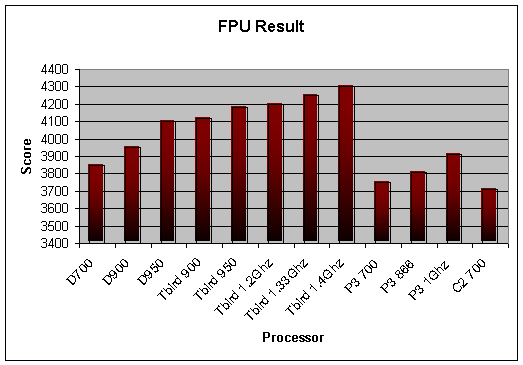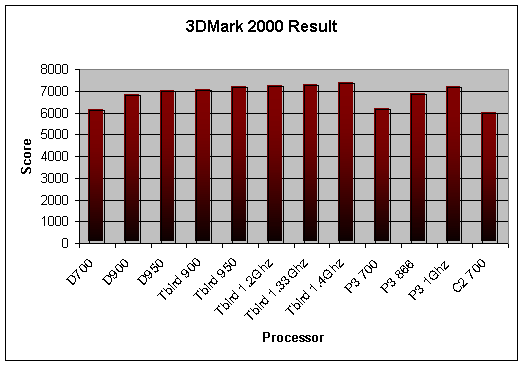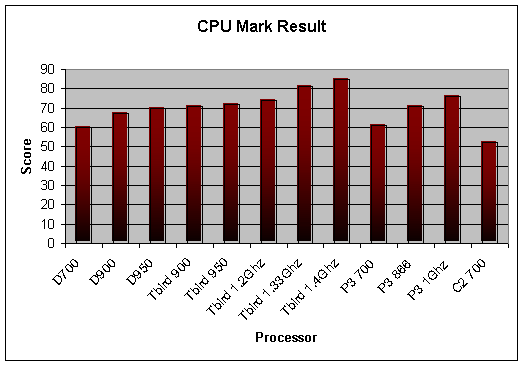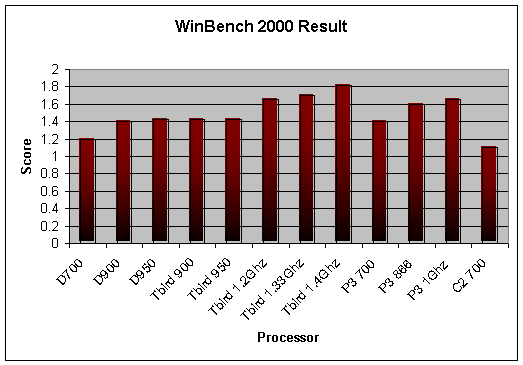AMD 1.4Ghz TBird
Ever since AMD released the Athlon CPU just over 2 years ago the market has been swept by this new platform, this coupled with the competitive pricing of the AMD processor range this has moved the x86 microprocessor market around a lot. AMD have recently launched the new core range of the "Athlon 4" or the "Palomino". This already has 2 high breeds on the market one in the form of the mobile processors with high amounts of speed step technology, and also in the 2P platform, a' la the SMP range of CPUs. The core differences between a Palomino and the Thunderbird are basically these, more transistors, data pre-fetch, and lower running temperature. AMD have totally left behind the standard 200 MHz bus speed. With the Thunderbird 1.4 CPU being purely DDR based. The 1.4 runs at a multiplier ratio of 10.5 and a bus speed of 266, giving the 1.4 GHz rate.The Palomino is not a new technology it is literally an updated Thunderbird core. AMD have got the 2P platform on to the market to compete with the Dual P3 platform and the Dual Xeon 4 Platform. AMD have been lucky in several cases. Firstly by releasing good quality, cheaper chips, and also with the flump of the Intel P4. This has assured AMD of a high spot in the market. The Pentium 4 still shows potential, but it appears that Intel needs to reorganise its pricing structure, and also head for a DDR platform (Which VIA have done now.. but we wont talk about that..)
When AMD launch these CPUs there are 2 main markets; the end-user who is mainstream and after a performance platform and then the big OEMs who will order big but also at a cut price. AMD have already managed to combat and dominate the primary sector for the past 18 months. They now look like they are breaking the OEMS away from Intel and building up this sector too. AMD still have the vision to sell to the value market. This is just like they had on the K6-X range of CPU, but the K6-X range really lacked the performance, which the Athlon doesn't. All of this isn't a bad thing. Their competitive pricing structure, high speed CPUs at lower-than-others pricing, is highly regarded in the industry showing that the company is a big player. If I told you 3 years ago you could get a GHz for under £60 would you believe me? If I had stated that AMD would have this position in the market I would just be laughed at. But they have turned it around and I am proud to run an AMD system.
With the launch of the 1.4 GHz Unit we see the possible death of one of the platforms. We will see DDR to grow from this point onwards. The primary memory platform is DDR. This is now a highly competitive region in the market and the prices you can get this memory for is astounding. The secondary type is the SDRam, which comes in 1 main flavour PC133. These 2 platforms are strong in their own ways.
DDR is a new dominant platform. It has a major advantage of being able to read on the rise and the fall of the clock. A DDR 133 Bus (PC2100) is equal to that of 266 due to the "double" reading upon the clock. The new 760MP motherboards are DDR only and this is due to the high amount of data needed to be read.
PC133 is an excellent platform especially when it is integrated and run on the KT133A motherboard where we have managed to hit bus speeds of around 155 and higher. This is an exceptional chipset, which is currently keeping SDRam very strongly positioned on the market. But since the release of the 1.4 AMD have decided to "drop" this platform.
There are 2 core breeds of AMD CPUs, the B and the C. The C is the DDR version, which is designed to run at this higher clock speed with the lower multiplier. The C version is an AMD Athlon that uses the 266MHz EVA bus. This can run on any motherboard KT133A and DDR compliant platforms.
This AMD 1.4 GHz DDR CPU is a high speed, low cost solution. It is now far superior in price/performance than any Intel CPU currently on the market. The major difference between the P4 and the Athlon TBird core is that the TBird has a "meer" 1.06GB/s memory bandwidth. Whilst the P4 has 3.2GB/s. this might kick in more so when the clock speeds of the P4s start to hit the 2GHz/ 2.2GHz regions, but until then the Netburst architecture isn't "maxed" out yet.

Tech Specs
Core - ThunderBird
Clock Speeds :- 750 - 1333MHz - Any More soon?
L1 Cache - 128KB
L2 Cache - 256KB
Speed of Cache - Same as Core
Cache Bus - 64 Bit
Interface - Socket 462 (Socket-A)
Microns - 0.18
Transistors - 37 Million
They are the only issues which AMD really have at the moment. One of the few
issues I have with this Thunderbird core is the high running temperature of the
unit. The Tunderbird core itself is a very strong and powerful architecture, but
the high speed means that it, in turn, runs very hot, which is linked to the
high voltage which is being sent to the CPU. This is soon to be updated by the
Palomino. The Palomino is an updated core, which has been developed not to need
any fans running on the actual heat sink unit, they have changed the voltage of
the CPU to around 1.45 volts which means that it wont run as hot as the
Thunderbird core CPU's at the same clock speed.
Currently there are 2 main DDR platforms which are available. The ALi MAGiK 1
solution and the AMD760. We have also seen a lot about the VIA KT266, but this
platform is still riddled with bugs, which need to be ironed out. Epox has
informed us that they have managed to solve most of the bugs in there new board.
The reason why AMD developed there own chipset was to enable to get the product
to market. They state: "We are a CPU manufacturer, not a chipset manufacturer".
This then backfired when the 760 chipset was the best performing and stable
chipset on the market.
AMD Testing System : -
Mobo - AMd Reference 760 Motherboard (ABit KT7E for the Duron)
Graphics Card - Visontek Geforce 3
Memory - 256MB Crucial PC133 Cas 2 RAM (256MB for DDR)
Cooling - Vantec Cooler
HD - 18GB Quantum Atlas 10K II
CD/DVD - Teac 32X CD ROM
Sound - SB Live 1024
Network - Intel Pro 100 Management
Intel Testing System :-
Mobo - Abit VP6 / Asus P3V4X for Celerons 2s
Graphics Card - Asus Geforce Pure 64MB
Memory - 256MB Crucial PC133 Cas 2 RAM
Cooling - GlobalWin WBK38
HD - 18GB Quantum Atlas 10K II
CD/DVD - Teac 32X CD ROM, 6X SCSI DVD ROM
Sound - Sound Blaster Live Platinum
Network - 10/100 3Com Management Card.
AMD decided to only release 1 unit this time unlike with the launch of the 1.3,
and 1.33 CPUs, the 1.4. The 1.4 runs on the '133MHz' bus (C Class). In 2000 a "meer"
fifteen retail AMD Athlon processors were launched, I wonder if the Palomino
will do the same.

From this graph you can see in the FPU results the 1.4Ghz DDR Module powered ahead by just under 100 points from the 1.33 Ghz unit. This shows the outstanding increase over all the other CPUs.

In our tests we used 3DMark 2000, the reason for not using 2001 is that we believe that 3DMark shows more graphics card need than CPU. But the CPU does have an impact. And as a lot of you readers know what your system will get under 2000 then it seems best to stick to it ;)

Again we see the 1.4GHz leading the edge here, all the performance which we have already seen is shown again. This CPU is again beating the other processors easily.

In Winbench the aim is to have a higher score, this software is for hardcore processor usage. As you can see they are all fairly close to one another but the 1.4 GHz thunderbird, just steps out ahead of the other CPUs.
If we look at this CPU the way we should.
Comparing it with the Intel P4, the 1.4 when running on a VIA (KT133X) Platform
totally beats the P4 1.5 all over. This is just astounding when Intel want more
money for their platform and memory. If you then try this CPU on an AMD760
chipset the CPU performance kicks in big time. It runs away from the P4 and also
the KT133A quite easily. To put it in to perspective, if you hit the CPU with an
AMD760 motherboard, and PC2100 DDR Ram the CPU is roughly completing tasks
within 80% of the time taken to do the tests on the other CPUs. This shows an
20% increase in performance in just cross talking between the KT133X platform
and the DDR platform.
When the 1.33 release went a ahead there was a few issues on the market. The
inquier reported that the CPUS were rare (ish) to get. Perhaps due to yields?
But according to AMD, OEMs and system integrators no longer have to worry about
the yields. They also know that AMD want to get as many CPUS out on to the
market as they can.
Back to the 1.4. Why is it good? Well not only in our tests does it perform VERY
well, but it is also an Athlon based CPU thus you know that the most important
thing is the price to performance ratio. Just think, the 1.33 and the other CPUs
will drop in price now so you could head out and get a bargain. We have also
heard about the core steppings of the 1.4s appearing on some 1.0GHz and 1.33GHz
units, clearly the demand for the 1GHz units far outstretched the amount AMD
suspected. This is a good sign showing we should have some high performance,
highly clockable CPUs. ;)













